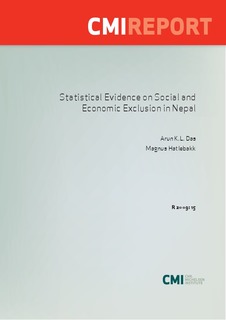| dc.description.abstract | The discourse on social exclusion in Nepal is very ideological, with some authors considering basically all Nepalis as socially excluded except for male Bahuns of hill origin. This is obviously not very useful for targeted economic and social interventions, and the present report attempts to provide statistical evidence on what population groups are de facto excluded along a number of economic and social dimensions. There are noticeable disparities in educational achievement, measured in terms of literacy and mean years of schooling. The hill Bahun/Chhetri group is ahead in terms of primary education, while the Tarai groups have less education, in particular the Dalits, amongst whom the Musahars have virtually no schooling. When it comes to health services, however, the Tarai communities have shorter travel distances to the health posts and better access to safe drinking water. In terms of the nutritional level of children under five, the mountain/hill Janajati groups are relatively well off, followed by the hill Bahun/Chettri group. For child mortality the hill Bahun/Chhetris have the lowest rate, while surprisingly the relatively wealthy Tarai middle castes have the highest. When it comes to economic variables, we focus on land as this is still the backbone of the rural economies. The traditional Tharu and Yadav landlords of the Tarai have the largest landholdings, while they are matched by the hill Bahun/Chhetri group in terms of land value. Most Tarai Dalits have no land, and in particular the Musahars are all landless. Landlessness combined with poor education have traditionally forced the Tarai Dalits to be farm laborers, where due to a poor bargaining position they accept very low agricultural wages. There has been some increase in the agricultural wage, but more so outside agriculture where in particular wages and salaries have increased for the hill Bahuns. | |
